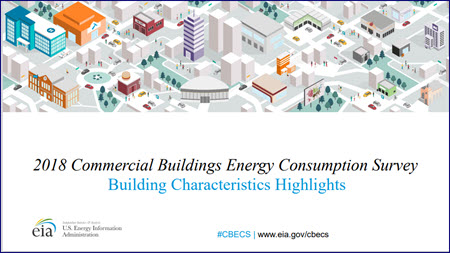
The Department of Energy (DOE) this week presented its latest data on energy use in U.S. commercial buildings. The nationwide information released by DOE’s Energy Information Administration (EIA) is the basis for ENERGY STAR building scores from the Environmental Protection Agency (EPA). (EIA final results and reports)
CBECS Results
- The latest Commercial Buildings Energy Consumption Survey (CBECS) reflects information collected in 2018. Although this is EIA’s newest building data, it is a “snapshot” in time—and does not account for occupancy rates or energy usage during or after the COVID-19 pandemic.
- According to the 2018 CBECS, there are an estimated 5.9 million public and private commercial buildings in the U.S. across non-residential asset classes—75% of which were constructed before the year 2000. (CBECS “building characteristics” highlights)
- Key CBECS findings on building energy consumption and expenditures include:
- Building energy efficiency improved compared to the 2012 survey.
Total floor space in commercial buildings increased yet energy consumption did not. Commercial buildings overall consumed 12% less energy per square foot of floor space in 2018 than in 2012.
- Electricity and natural gas accounted for about 94% of energy consumed.
Electricity accounted for 60% of energy consumed (mostly for cooling) and natural gas for 34% (mostly for heating).
- Large buildings were fewer but consumed over one-third of energy.
Buildings over 100,000 square feet accounted for 2% of all commercial buildings—yet covered 34% of total commercial floor space. The newest buildings were the most energy intensive.
- Commercial buildings spent $141 billion on energy in 2018, averaging $1.46 per square foot.
Commercial buildings spent $119 billion on electricity, or 84% of their total energy expenditures. Natural gas accounted for 12% of total commercial building energy expenditures ($16 billion).
- Space heating accounted for close to one-third of end-use consumption.
Space heating was the most energy-intensive end use, especially in colder climates. Office equipment and computing were the least intensive end uses.
ENERGY STAR & NextGen Label

- EPA’s successful ENERGY STAR score—an efficiency rating for buildings—is generally based on CBECS data.
- EPA is expected to update its models for calculating ENERGY STAR ratings in 2025, under the newly-released 2018 CBECS data. The anticipated update could greatly alter a building’s current ENERGY STAR score (presently based on 2012 CBECS data).
- EPA recently proposed a new voluntary label for low-carbon buildings. The NextGen label would expand upon ENERGY STAR and recognize buildings that use significant percentages of solar and other forms of renewable energy.
The Real Estate Roundtable submitted comments to EPA last month on the NextGen building label proposal. (Roundtable letter and Roundtable Weekly, March 3)
# # #
